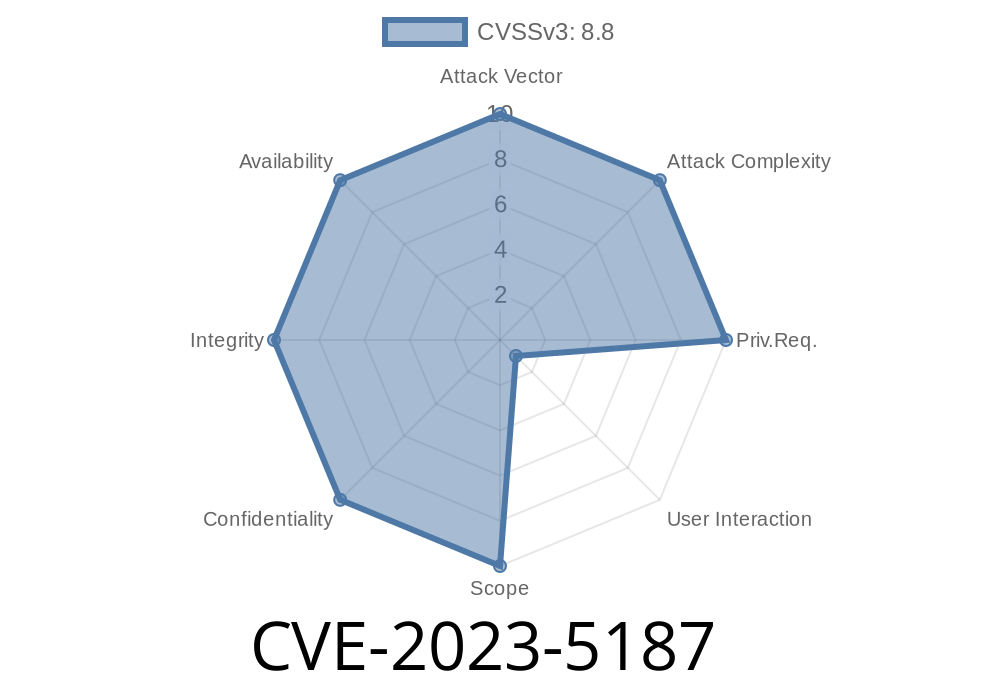CVE-2023-5187 is a high-severity security vulnerability identified in Google Chrome before version 117..5938.132. The vulnerability affects the Extensions component and could lead to a use-after-free exploit in the browser. An attacker who successfully convinces a user to install a malicious Chrome extension can leverage the vulnerability to corrupt the browser's heap via a specially crafted HTML page, thereby disrupting the normal functionality of the browser and potentially compromising user security. In this post, we will investigate the nature of the exploit, dive into a code snippet that demonstrates the issue, and provide links to critical resources and references for understanding and mitigating the vulnerability.
Vulnerability Details
CVE-2023-5187, as mentioned earlier, is a use-after-free vulnerability present in Chrome's Extension system. Use-after-free errors occur when a program continues to use a pointer after the associated memory has been freed. This can result in memory corruption, crashes, or even code execution in certain circumstances. In the case of this vulnerability, an attacker can take advantage of the heap corruption to escalate their privileges within the browser, potentially stealing sensitive user data or performing other malicious activities.
Exploit Walkthrough
To better understand the exploit, let's examine a code snippet that demonstrates the vulnerability in action:
1. The attacker crafts an HTML page containing a malicious script and manages to convince the user to visit the page.
<html>
<head>
<script>
function triggerUAF() {
// ...
// Malicious code that takes advantage of the use-after-free vulnerability.
// ...
}
</script>
</head>
<body onload="triggerUAF()">
</body>
</html>
2. Through social engineering or other tactics, the attacker convinces the user to install a malicious Chrome Extension, e.g., under the guise of a utility tool or a game. The extension includes a file (such as a JavaScript file) that attempts to interact with the malicious HTML page and its script.
3. Upon interaction between the extension and the malicious HTML page, the use-after-free vulnerability is triggered, leading to heap corruption in the browser.
4. The attacker can further exploit the corrupted heap to escalate their privileges, access sensitive information, or execute additional malicious code within the user's browser.
Mitigation Measures
Since the release of Chrome version 117..5938.132, Google has patched this specific vulnerability. It is crucial for users to update their Google Chrome browser to the latest version to protect against potential exploitation. To verify the current Chrome version and update if necessary, take the following steps:
If the version is out of date, follow the prompts to update Chrome.
Furthermore, users should exercise caution when installing extensions or visiting unknown or untrusted websites. Limiting the number of installed extensions and only installing those from known and trusted developers can help reduce the attack surface for these types of vulnerabilities.
Original References and Resources
Below are critical resources for understanding, reproducing, and mitigating the CVE-2023-5187 vulnerability:
- Chromium Security Advisory - Chromium's original announcement regarding the vulnerability and patch.
- CVE-2023-5187 NIST NVD Entry - National Vulnerability Database's entry for this specific vulnerability, providing additional details and references.
- Understanding Use-After-Free Vulnerabilities - An in-depth explanation of use-after-free exploits and their implications, provided by OWASP.
- Google Chrome Security Best Practices - Official documentation providing guidelines for maintaining security while using the Google Chrome browser.
Conclusion
CVE-2023-5187, a high-severity vulnerability in Google Chrome, can lead to heap corruption and further exploitation through a malicious Chrome extension interacting with a compromised HTML page. Ensuring your browser is up-to-date and minimizing your usage of potentially unsafe extensions is key to protecting yourself from this and similar exploits. Leveraging the resources provided above, users can stay informed and vigilant against such vulnerabilities, thereby safeguarding their browsing experience.
Timeline
Published on: 09/28/2023 16:15:10 UTC
Last modified on: 10/12/2023 02:45:40 UTC
